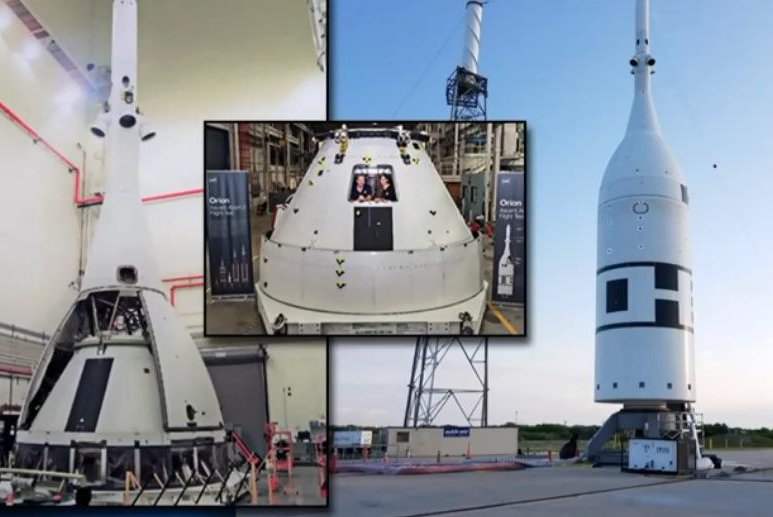NASA to test new capsule abort system in Florida
July 1, 2019
By Paul Brinkmann

A composite of photos shows the Orion test capsule in the middle, attached to the launch-abort structure at left and on top of the rocket vehicle at right. Photo courtesy of NASA
July 1 (UPI) -- NASA is scheduled to test a new launch-abort system in Florida on Tuesday as part of its planned Artemis human spaceflight missions to the moon and possibly Mars.
It's part of NASA's certification of the new Orion spacecraft, a capsule designed to carry humans to the moon and bring them back safely. This would be the third of five launches to test the capsule system.
"The is the fastest-accelerating launch abort system ever designed," astronaut Randy Bresnick said in a press conference Monday. "The neat part is, the next time this launch abort system flies, there will be crew underneath it."
Tuesday's test will carry a model of the capsule on top of a refurbished first-stage rocket engine from a Peacekeeper intercontinental ballistic missile.
The test launch is planned for 7 a.m. from Launch Complex 46 at Cape Canaveral Air Force Station, with a four-hour window for possible delays.
NASA says the rocket will travel to about 45,000 feet before the launch-abort structure on top of the capsule fires and pulls it from the rocket. At that point, the rocket should be traveling about 800 mph.
As it descends, the abort structure will fire more rockets and detach from the capsule, which is expected to hit the Atlantic Ocean at about 300 mph, most likely breaking apart. Parachutes won't be used, since the only goal of the launch is to test the abort system.
"It's a big improvement over the Apollo system," said Mark Kirasich, NASA's Orion program manager.
The biggest advance is an attitude control motor that allows proper orientation of the capsule after it breaks off the rocket itself, he said. That allows a broader range of conditions under which the abort system will work to safely remove astronauts from the dangerous, fuel-filled rocket.
Data from the test will be sent via telemetry to NASA computers, but 12 additional recorders are set drop into the ocean separately to provide more data as a backup. NASA should be able to pick them up quickly using homing signal beacons, said Jenny Devolites, the space agency's conductor for the test, called Ascent Abort-2.
The Air Force weather squadron has predicted that Tuesday will be 70 percent favorable for launch. Should a delay occur, another attempt can be made Wednesday at the same time, with weather outlook improving to 80 percent favorable.
Kirasich said the next step is another series of tests of the real Orion spacecraft after it is mounted together with its lander module -- in a lab environment.

 www.upi.com
www.upi.com
July 1, 2019
By Paul Brinkmann
A composite of photos shows the Orion test capsule in the middle, attached to the launch-abort structure at left and on top of the rocket vehicle at right. Photo courtesy of NASA
July 1 (UPI) -- NASA is scheduled to test a new launch-abort system in Florida on Tuesday as part of its planned Artemis human spaceflight missions to the moon and possibly Mars.
It's part of NASA's certification of the new Orion spacecraft, a capsule designed to carry humans to the moon and bring them back safely. This would be the third of five launches to test the capsule system.
"The is the fastest-accelerating launch abort system ever designed," astronaut Randy Bresnick said in a press conference Monday. "The neat part is, the next time this launch abort system flies, there will be crew underneath it."
Tuesday's test will carry a model of the capsule on top of a refurbished first-stage rocket engine from a Peacekeeper intercontinental ballistic missile.
The test launch is planned for 7 a.m. from Launch Complex 46 at Cape Canaveral Air Force Station, with a four-hour window for possible delays.
NASA says the rocket will travel to about 45,000 feet before the launch-abort structure on top of the capsule fires and pulls it from the rocket. At that point, the rocket should be traveling about 800 mph.
As it descends, the abort structure will fire more rockets and detach from the capsule, which is expected to hit the Atlantic Ocean at about 300 mph, most likely breaking apart. Parachutes won't be used, since the only goal of the launch is to test the abort system.
"It's a big improvement over the Apollo system," said Mark Kirasich, NASA's Orion program manager.
The biggest advance is an attitude control motor that allows proper orientation of the capsule after it breaks off the rocket itself, he said. That allows a broader range of conditions under which the abort system will work to safely remove astronauts from the dangerous, fuel-filled rocket.
Data from the test will be sent via telemetry to NASA computers, but 12 additional recorders are set drop into the ocean separately to provide more data as a backup. NASA should be able to pick them up quickly using homing signal beacons, said Jenny Devolites, the space agency's conductor for the test, called Ascent Abort-2.
The Air Force weather squadron has predicted that Tuesday will be 70 percent favorable for launch. Should a delay occur, another attempt can be made Wednesday at the same time, with weather outlook improving to 80 percent favorable.
Kirasich said the next step is another series of tests of the real Orion spacecraft after it is mounted together with its lander module -- in a lab environment.

NASA to test new capsule abort system in Florida - UPI.com
NASA is scheduled to test a new launch abort system in Florida on Tuesday as part of its planned Artemis human spaceflight missions to the moon.
